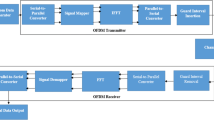Abstract
Since one of major problems of OFDM-based systems is high peak-to-average-power ratio (PAPR) of its transmitted signal, many PAPR reduction techniques and combined schemes with individual techniques have recently been developed. Among various techniques, the clipping technique has been widely used as a practical scheme owing to its low computational complexity and simplicity in implementation, while the selected mapping (SLM) technique is known to provide good PAPR reduction performance without signal distortion. Generally, the combined scheme of two PAPR reduction techniques, which are the clipping and the SLM, is expected to provide the enhanced performance of PAPR reduction, because the clipping noise of combined scheme would be less than that of single clipping technique, when the SLM technique is employed before clipping. However, the performance of clipping scheme with SLM technique has not been evaluated for practical systems over fading channels. In this paper, the performance of the clipping scheme with the SLM technique is theoretically analyzed and compared with simulation results over fading channels. The performance of combined scheme is analyzed with various clipping ratios, phase sets for SLM, and modulation schemes over flat and frequency selective fading channels. In addition, the effects of the clipping at the receiver and the oversampling on the BER performance are discussed. Based on the results of analysis, therefore, one can design the effective clipping scheme with the SLM technique for the PAPR reduction of OFDM-based systems.
Similar content being viewed by others
References
Li X., Cimini L. J. Jr. (1998) Effects of clipping and filtering on the performance of OFDM. IEEE Communication Letters 2(5): 131–133
Armstrong J. (2002) Peak-to-average power reduction for OFDM by repeated clipping and frequency domain filtering. Electronics Letters 38: 246–247
Jones A. E., Wilkinson T. A., Barton S. K. (1994) Block coding scheme for reduction of peak to mean envelope power ratio of multicarrier transmission scheme. Electronics Letters 30: 2098–2099
Wilkinson, T. A., & Jones, A. E. (1995). Minimization of the peak to mean envelop power ratio in multicarrier transmission schemes by block coding. In Proceedings IEEE vehicular technology conference (pp. 825–831). Chicago, IL, July.
Wulich D. (1996) Reduction of peak to mean ratio of multicarrier modulation by cyclic coding. Electronics Letters 32(5): 432–433
Li X., Ritcey J. A. (1997) M-sequences for OFDM peak-to-average power ratio reduction and error correction. Electronics Letters 33: 554–555
Tarokh V., Jafarkhani H. (2000) On the computation and reduction of the Peak-to-average power ratio in multicarrier communications. IEEE Transactions on Communications 48(1): 37–44
Davis J.A., Jedwab J. (1997) Peak-to-mean power control and error correction for OFDM transmission using golay sequences and Reed-Muller codes. Electronics Letters 33(4): 267–268
Davis J.A., Jedwab J. (1999) Peak-to-mean power control in OFDM, golay complementary sequences, and Reed-Muller codes. IEEE Transations on Information Theory 45(7): 2317–2397
Patterson K.G. (2000) Generalized Reed-Muller codes and power control in OFDM modulation. IEEE Transations on Information Theory 46(1): 104–120
Paterson K.G., Tarokh V. (2000) On the existence and construction of good codes with low peak-to-average power ratios. IEEE Transations on Information Theory 46(6): 1974–1987
Chong C.V., Tarokh V. (2001) A simple encodable/decodable OFDM QPSK code with low peakto- mean envelope power ratio. IEEE Transations on Information Theory 47(7): 3025–3029
Bauml R.W., Fischer R.F.H., Huber J.B. (1996) Reducing the peak-to-average power ratio of multicarrier modulation by selected mapping. Electronics Letters 32: 2056–2057
Muller S.H., Huber H.B. (1997) OFDM with reduced peak-to-mean power ratio by optimum combination of partial transmit sequences. Electronics Letters 33: 368–369
Jayalath A.D.S., Tellambura C. (2000) Reducing the peak-to-average power ratio of orthogonal frequency division multiplexing singal through bit or symbol interleaving. Electronics Letters 36(13): 1161–1163
Tellado, J. (1999). Peak to average power reduction for multicarrier modulation. Ph.D dissertation, Stanford university, Sept.
Yoo S., Yoon S., Kim S.Y., Song I. (2006) A novel PAPR reduction scheme for OFDM systems: Selective mapping of partial tones (SMOPT). IEEE Transactions on Consumer Electronics 52(1): 40–43
Krongold B.S., Jones D.L. (2003) PAR reduction in OFDM via active constellation extension. IEEE Transations on Broadcasting 49(3): 258–268
Huang X., Lu J., Zheng J., Letaief K.B., Gu J. (2004) Companding transform for reduction in peak-to-average power ratio of OFDM signals. IEEE Transations on Wireless Communications 03(6): 2030–2038
Jiang T., Zhu G. (2004) Nonlinear companding transform for reducing peak-to-average power ratio of OFDM signals. IEEE Transations on Broadcasting 50(3): 342–346
Jiang T., Yang Y., Song Y.H. (2005) Exponential companding technique for PAPR reduction in OFDM systems. IEEE Transations on Broadcasting 51(2): 244–248
Wang X., Tjhung T.T., Wu Y. (2003) On the SER and spectral analyses of A-law companded multicarrier modulation. IEEE Transations on Vehicular Technology 52(5): 1408–1412
Wang X., Tjhung T.T., Ng C.S. (1999) Reduction of peak-to-average power ratio of OFDM system using a companding technique. IEEE Transations on Broadcasting 45(3): 303–307
Jiang T., Wu Y. (2008) An overview: Peak-to-average power ratio reduction techniques for OFDM signals. IEEE Transactions on Broadcasting 54(2): 257–268
Ochiai H., Imai H. (2000) Performance of the deliberate clipping with adaptive symbol selection for strictly band-limited OFDM systems. IEEE Journal on Selected Areas in Communications 18: 2270–2277
O’Neil, R., Lopes, L. N. (1995). Envelop variations and spectral splatter in clipped multicarrier signals. In Proceedings of IEEE international symposium on personal, indoor and mobile radio communications, PIMRC’95, 1 pp. 71–75.
Wang L., Tellambura C. (2005) A simplified clipping and filtering technique for PAR reduction in OFDM systems. IEEE Signal Processing Letters 12(6): 453–456
Goldsmith A. (2005) Wireless communications. Cambridge University Press, Cambridge, MA
Baek M., Kim M., You Y., Song H. (2004) Semi-blind channel estimation and PAR reduction for MIMO-OFDM sysmtem with multiple antennas. IEEE Transations on Broadcasting 50(4): 414–424
Author information
Authors and Affiliations
Corresponding author
Rights and permissions
About this article
Cite this article
Lee, B.M., Kim, Y. & de Figueiredo, R.J.P. Performance Analysis of the Clipping Scheme with SLM Technique for PAPR Reduction of OFDM Signals in Fading Channels. Wireless Pers Commun 63, 331–344 (2012). https://doi.org/10.1007/s11277-010-0136-z
Published:
Issue Date:
DOI: https://doi.org/10.1007/s11277-010-0136-z




